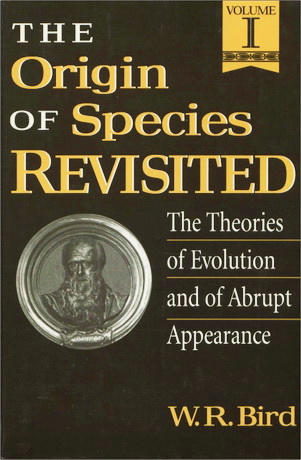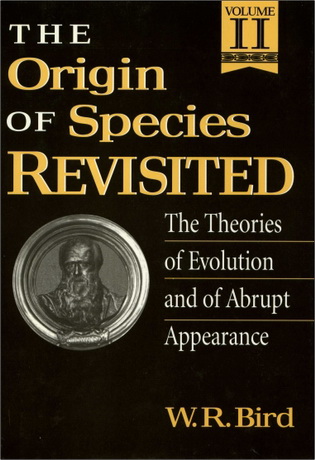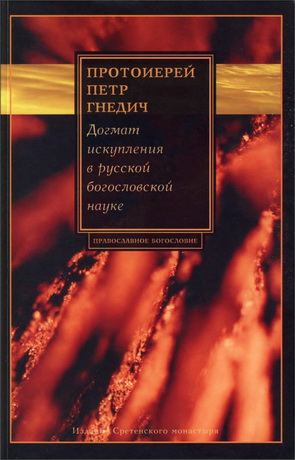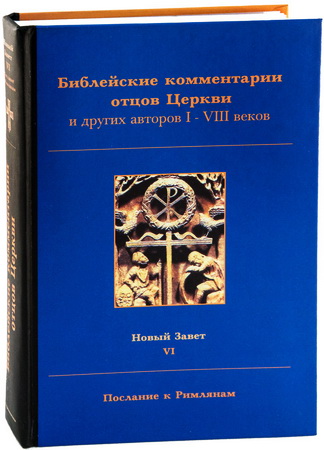
Bird - The Origin of Species Revisited - volume I-II

All facts fit all theories. That is a fact of life. Facts fit some theories better than other theories, and that is another fact of life, one which enables science to progress, when a better theory is created by the human spirit. In this book the lawyer W.R. Bird compares two theories, evolution and abrupt appearance. He argues that the facts of life and of the universe fit them both, but fit the theory of abrupt appearance as well as or better than the theory of evolution.
Mr. Bird’s is not the first attempt to argue this case, nor will it be the last, but it is perhaps the most scholarly effort among many of this kind to appear in recent years. In this respect it contrasts starkly with most, and perhaps all, of the “creation science” literature that has so far been published.
W. R. Bird - The Origin of Species Revisited - The Theories of Evolution and of Abrupt Appearance - volume I
Published in Nashville, Tennessee, by Thomas Nelson, Inc., and distributed in Canada by Lawson Falle, Ltd., Cambridge, Ontario 1991 - 562
ISBN Vol. I 0-8407-68454-1
W. R. BIRD - THE ORIGIN OF SPECIES REVISITED. The Theories of Evolution and of Abrupt Appearance. VOLUME I: SCIENCE - Contents
ACKNOWLEDGMENTS
PREFACES
- by Dr. Gareth J. Nelson
- by Dr. Dean H. Kenyon
INTRODUCTION
PART I. What Are the Theories of Evolution and Abrupt Appearance?
Chapter 1. Definitions of the Theory of Evolution and the Theory of Abrupt Appearance
- 1.1 The Definitions of Evolution and Abrupt Appearance
- 1.2 The Religious Meanings of Evolution and Creation
PART II. Whether the Theories of Abrupt Appearance and Evolution Are Scientific The Origin of the Various Living Organisms
Chapter 2. Theories of Abrupt Appearance and Empirical Evidence: Biological Abrupt Appearance of Living Organisms
- 2.1 The Paleontology Argument: Empirical Evidence of Systematic Abrupt Appearances
- 2.2 The Paleontology Argument: Empirical Evidence of Systematic Gaps
- 2.3 The Comparative Morphology Argument: Empirical Evidence of Systematic Similarity and Stasis
- 2.4 The Information Content Argument: Natural Laws of Information Science
- 2.5 The Probability Argument: Natural Laws Reflected in Statistics
- 2.6 The Genetics Argument: Natural Law of Limited Change
- 2.7 The Comparative Discontinuity Argument: Empirical Evidence from Classification, Comparative Anatomy, and Comparative Biochemistry
Chapter 3. Evolution as Theory and Conjecture: Biological Evolution (Macroevolution) of Living Organisms
- 3.1 The Meanings of Biological Evolution: Macroevolution and Darwinism and Fact
- 3.2 The Approaches to Macroevolution: Darwinian, Anti-Darwinian, and Anti-Evolutionist Schools
- 3.3 The Postulated Mechanisms of Macroevolution: Natural Selection, Species Selection, and Other Factors
- 3.4 The Postulated Evidence for Macroevolution and Darwinism: Darwinian Arguments and the Disintegrating Neo-Darwinian Synthesis
- 3.5 The Postulated Stages of Macroevolution and Darwinism: Single Cells to All Plants and Animals and Missing Links
PART III. Whether the Theories of Abrupt Appearance and Evolution Are Scientific The Origin of the First Life
Chapter 4. Theories of Abrupt Appearance and Empirical Evidence: Biochemical Abrupt Appearance of the First Life
- 4.1 The Information Content Argument: Natural Laws of Information Science
- 4.2 The Probability Argument: Natural Laws Reflected in Statistics
- 4.3 The Isomers Argument: Empirical Evidence of Left-Handed Amino Acids and Right-Handed Sugars
- 4.4 The Biogenesis Argument: Natural Law of Life from Life
- 4.5 The Thermodynamics Argument: Natural Law of Increasing Disorder
Chapter 5. Evolution as Theory and Conjecture: Biochemical Evolution of the First Life
- 5.1 The Early Atmosphere for Biochemical Evolution:Questions about an Oxygen-Free Composition
- 5.2 The Primordial Soup for Biochemical Evolution: Questions about Significant Organic Compounds
- 5.3 The Stages of Biochemical Evolution: Questions about the Critical Elements for Life
- 5.4 The Laboratory Experiments for Biochemical Evolution: Questions about Extrapolation to Life
PART IV. Whether the Theories of Abrupt Appearance and Evolution Are Scientific The Origin of the Universe
Chapter 6. Theories of Abrupt Appearance and Empirical Evidence: Cosmic Abrupt Appearance of the Universe
- 6.1 The Thermodynamics Argument: Natural Laws Requiring Abrupt Appearance
- 6.2 The Information Content Argument: Natural Laws of Information Science
- 6.3 The Anthropic Principle Argument: Empirical Evidence of Scientific Teleology
- 6.4 The Heterogeneity Argument: Empirical Evidence of Abrupt Appearance of the Universe
- 6.5 The Galaxy and Star Formation Argument: Empirical Evidence of Abrupt Appearance of Celestial Bodies
- 6.6 The Radiohalos Argument: Empirical Evidence of Abrupt Appearance of the Earth
Chapter 7. Evolution as Theory and Conjecture: Cosmic Evolution of the Universe
- 7.1 The Big Bang and Inflationary Universe Theories: Description of Cosmic Evolution
- 7.2 The Primary Evidence for the Big Bang Theory: Questions from Alternative Explanations
- 7.3 The Stages of the Big Bang: Questions about the Critical Events
Chapter 8. Summary of the Scientific Issues: The Theory of Abrupt Appearance and the Theory of Evolution
- 8.1 Definitions of the Theories of Evolution and Abrupt Appearance
- 8.2 The Theory of Biological Abrupt Appearance of Living Organisms
- 8.3 The Theory of Biological Evolution of Living Organisms
- 8.4 The Theory of Biochemical Abrupt Appearance of the First Life
- 8.5- The Theory of Biochemical Evolution of the First Life
- 8.6 The Theory of Cosmic Abrupt Appearance of the Universe
- 8.7 The Theory of Cosmic Evolution of the Universe
AUTHOR INDEX
SUBJECT INDEX
THE AUTHOR
W. R. BIRD - THE ORIGIN OF SPECIES REVISITED. The Theories of Evolution and of Abrupt Appearance. VOLUME I: SCIENCE - INTRODUCTION
For I am well aware that scarcely a single point is discussed in this volume on which facts cannot he adduced, often apparently leading to conclusions directly opposite to those at which I have arrived. A fair result can be obtained only by fully stating and balancing the facts and arguments on both sides of each question ....
—Charles Darwin, in Introduction to The Origin of Species
Species by Means of Natural Selection or the Preservation of Favoured Races in the Struggle for Life.” That single volume has had a massive influence not only on the sciences, which increasingly are built on evolutionary assumptions, but on the humanities, theology, and government.
Darwin’s revolution in science grew from the concept that one or a few original single-celled organisms evolved into invertebrates, then into fish, then into amphibians, then into reptiles, then into lower mammals, then into primates, then into man. Darwin speculated, and others proposed, that the original single-celled organ¬ isms themselves evolved from nonlife. That evolutionary view soon combined with concepts that the physical universe has evolved from primordial chaos to its present order, that concepts of the deity and inspired writings evolved in changing cultures, that human knowledge and values evolved in a universe without absolute truth, and that governmental institutions and their foundational documents do and in fact should evolve in form and meaning.
On the centennial of Darwin’s book, the scientific community was still divided over a viable mechanism to explain the assumed evolution from nonlife to life and from single-celled life to all plants and animals in their vast complexity. In the following quarter century, a growing scientific challenge arose to critical elements of Darwinian evolution, and an even faster growing scientific challenge emerged about the truth of Darwinian evolution itself. The dissent seems to be so widespread as to indicate a Kuhnian revolution in science and a paradigm shift.
The challenge to critical elements of Darwinism came from many directions: initially anti-selectionists and evolutionary saltationists who found natural selection inadequate to propel microevolution into macroevolution or to explain a fossil record of systematic gaps; recently punctuated equilibria advocates who replace the mechanism of biological evolution and its misreading of microevolution and of the fossil record, transformed cladists and some pheneticists who question the truth of evolution or its relevance to classification, and neutral selectionists, nonequilibrium thermodynamics proponents, and structuralists; and generally specialists in every field who find no persuasive evidence of Darwinian evolution in their own field but assume that the evidence is present in another field.
Many paleontologists, while supposing that the evidence for Darwinian macroevolution is in another field, concede that “no real evolutionist, whether gradualist or punctuationist, uses the fossil record as evidence in favour of the theory of evolution ...” (Ridley). Although reliance is often placed on evolutionary trees, “phylo- genies grew up like weeds” for “even organisms with no fossils available” (Boyden), and are “meaningless waffle” (Charig). Many evolutionists look to the field of classification or systematics for the key evidence, but “much modern taxonomy has abandoned its Darwinian, historicist or genealogical approach” (Oldroyd), such as the transformed cladists who “have taken more or less extreme measures to sever their ties” from evolutionary biology and Introduction are “at odds with evolutionary thinking” (Beatty). Comparative anatomists often look to another discipline, because so widespread are convergences and parallelisms that “[m]ore often than not functional comparisons turned up phylogenetic paradoxes instead of parallels” (Ross).
 W. R. Bird - The Origin of Species Revisited - The Theories of Evolution and of Abrupt Appearance - volume II: PHILOSOPHY OF SCIENCE, PHILOSOPHY OF RELIGION HISTORY, EDUCATION, AND CONSTITUTIONAL ISSUES
W. R. Bird - The Origin of Species Revisited - The Theories of Evolution and of Abrupt Appearance - volume II: PHILOSOPHY OF SCIENCE, PHILOSOPHY OF RELIGION HISTORY, EDUCATION, AND CONSTITUTIONAL ISSUES
Published in Nashville, Tennessee, by Thomas Nelson, Inc., and distributed in Canada by Lawson Falle, Ltd., Cambridge, Ontario 1991 – 591
ISBN Vol. I 0-8407-68454-1
ISBN Vol. II 0-8407-6848-6
W. R. Bird - The Origin of Species Revisited - The Theories of Evolution and of Abrupt Appearance - volume II: PHILOSOPHY OF SCIENCE, PHILOSOPHY OF RELIGION HISTORY, EDUCATION, AND CONSTITUTIONAL ISSUES - Contents
PREFACES
- by Dr. Robert M. Augros
- by Dr. W. Scot Morrow
- by Dr. Russell L. French
INTRODUCTION
PART V. Whether the Theories of Abrupt Appearance and Evolution Are Scientific? The Definitions of Science
Chapter 9. Accepted Definitions of Science and the Radical Definition
- 9.1 Prevailing Definitions of Science: Empirical Observations and Logical Interpretations
- 9.2 Textbook Definitions of Science: Ubiquitous Presentation and Unanimous Rejection
- 9.3 McLean Case Definition of Science: Tactically Contrived against Discontinuitist Theories
- 9.4 Natural Laws and the Demarcation of Science: Difference between Existence and Explanation
- 9.5 Testability and Falsifiability and the Demarcation of Science: Difference between Historical Sciences and Other Sciences
- 9.6 Tentativeness and the Demarcation of Science: Difference between Science and Scientists
- 9.7 Majority Assessment by Scientists: Inconclusive Criterion of Science
Chapter 10. Theories of Evolution and Abrupt Appearance and Various Definitions of Science
- 10.1 Comparable Satisfaction of Prevailing Definitions by the Theories of Abrupt Appearance and Evolution
- 10.2 Comparable Explanation with Natural Laws by the Theories of Abrupt Appearance and Evolution
- 10.3 Comparable Testability of the Theories of Abrupt Appearance and Evolution
- 10.4 Comparable Falsifiability of the Theories of Abrupt Appearance and Evolution
- 10.5 Comparable Tentativeness of the Theories of Abrupt Appearance and Evolution
- 10.6 Other Comparable Characteristics of the Theories of Abrupt Appearance and Evolution
Chapter 11. Theories of Evolution and Abrupt Appearance as Sole Scientific Alternatives
- 11.1 Evolutionist Acknowledgment of These Sole Alternatives
- 11.2 Logical Recognition of These Sole Alternatives
PART VI. Whether the Theories of Abrupt Appearance and Evolution Are Non-Religious? The Definitions of Religion
Chapter 12. Theories of Evolution and Abrupt Appearance and Prevailing Definitions of Religion
- 12.1 Philosophical Definitions of Religion
- 12.2 Judicial Definitions of Religion
- 12.3 The Theories of Evolution and Abrupt Appearance and Religion
Chapter 13. Theories of Evolution and Abrupt Appearance and Concepts of Abrupt Appearance, Creation, and a Creator
- 13.1 Non-Religious Nature of Scientific Evidence Supporting the Theories of Abrupt Appearance and Evolution
- 13.2 Non-Centrality of a Creator to the Theories of Abrupt Appearance and Evolution when Properly Defined
- 13.3 Non-Religious Parallel Relation to a Creator and Creation of the Theories of Evolution and Abrupt Appearance
- 13.4 Non-Religious Role in Scientific History of a Creator and Creation
- 13.5 Non-Religious Parallel Relation to World Views of the Theories of Evolution and Abrupt Appearance
Chapter 14. Theories of Evolution and Abrupt Appearance and Consistency with Religion
- 14.1 Non-Religious Nature of the Consistency of the Theory of Evolution with Various Religions
- 14.2 Non-Religious Nature of the Parallel Consistency of the Theory of Abrupt Appearance with Various Religions
- 14.3 Non-Religious Nature of Other Parallels between the Theories of Abrupt Appearance and Evolution
PART VII. Whether the Theories of Abrupt Appearance and Evolution Are Non-Religious? The History of the Creation-Evolution Controversy
Chapter 15. Theories of Evolution and Abrupt Appearance and the History of Religious Involvement
- 15.1 Religious Involvement on the Evolutionist Side of the Creation-Evolution Controversy
- 15.2 Scientific Involvement on the Creationist Side of the Creation-Evolution Controversy
- 15.3 Parallel Religious Involvement on the Creationist Side of the Creation-Evolution Controversy
Chapter 16. Theories of Evolution and Abrupt Appearance and Recent Political Activity
- 16.1 Active Lobbying by Evolutionist Organizations in the Evolution Controversy
- 16.2 Political Non-Involvement by Leading Creationist Scientists toward Balanced Treatment Legislation
PART VIII. Whether the Theories of Abrupt Appearance and Evolution Are Educationally Valuable? The Educational Feasibility of Uncensored Instruction
Chapter 17. The Educational Method of Contrasting Explanations and the Theories of Evolution and Abrupt Appearance
- 17.1 Educational Merit of Contrasting Explanations
- 17.2 Educational Merit of Contrasting All Scientific Theories of Origins
Chapter 18. The Current Educational Bias in Favor of the Theory of Evolution and Against the Theory of Abrupt Appearance
- 18.1 Extensive Treatment of the Theory of Evolution and Exclusion of the Theory of Abrupt Appearance in Most Public Educational Institutions
- 18.2 Discrimination against Discontinuitist Scientists and Educators by Educational Institutions and Publications
PART IX. Whether Instruction in All Scientific Theories of Origins Is Constitutional? Academic Freedom and Separation of Church and State
Chapter 19. The Academic Freedom of Students To Receive and of Teachers To Teach More Scientific Information
- 19.1 Advancement of Students' Right To Receive Information by Uncensored Instruction
- 19.2 Advancement of Many Teachers' Academic Freedom by Uncensored Instruction
Chapter 20. The Constitutionality under the Establishment Clause of Public Instruction in “All Scientific Theories of Origins"
- 20.1 The Constitutionality under the Historical Test for the Establishment Clause of Teaching All Scientific Theories of Origins
- 20.2 The Constitutionality under the Tripart Test for the Establishment Clause of Teaching All Scientific Theories of Origins
Chapter 21. Summary of the Philosophy, Theology, Education, and Constitution Issues: The Theory of Abrupt Appearance and the Theory of Evolution
- 21.1 The Accepted Definitions of Science and the Radical Definition
- 21.2 The Theories of Evolution and Abrubt Appearance and the Various Definitions of Science
- 21.3 The Theories of Evolution and Abrupt Appearance and Other Theories of Origins
- 21.4 The Theories of Evolution and Abrupt Appearance and the Prevailing Definitions of Religion
- 21.5 The Theories of Evolution and Abrupt Appearance and the Concepts of Abrupt Appearance, Creation, and a Creator
- 21.6 The Theories of Evolution and Abrupt Appearance and Consistency with Religion
- 21.7 The Theories of Evolution and Abrupt Appearance and the History of Religious Involvement and Political Activity
- 21.8 The Theories of Evolution and Abrupt Appearance and the Educational Method of Contrasting Explanations
- 21.9 The Theories of Evolution and Abrupt Appearance and the Academic Freedom of Students and Teachers
- 21.10 The Theories of Evolution and Abrupt Appearance and the Constitutionality of Teaching “All Scientific Theories of Origins”
CREDITS
AUTHOR INDEX
SUBJECT INDEX
W. R. BIRD - THE ORIGIN OF SPECIES REVISITED. The Theories of Evolution and of Abrupt Appearance. VOLUME II: PHILOSOPHY OF SCIENCE, PHILOSOPHY OF RELIGION HISTORY, EDUCATION, AND CONSTITUTIONAL ISSUES - Introduction
Volume I addressed the scientific evidence for the theory of evolution and for the theory of abrupt appearance. It found that biological, biochemical, and cosmic evolution are “in crisis,” that dissent is widespread and mounting, and that the challenge comes even more from disillusioned evolutionists than from creationists. Each stage of evolution, and each argument for evolution, has empirical difficulties that are acknowledged by some specialists in the field, as summarized in Chapter.
At the same time, the theory of abrupt appearance, in its biological, biochemical, and cosmic aspects, has difficulties and needs further research. However, that theory consists of affirmative lines of scientific evidence, such as the paleontology argument of the widespread abrupt appearance of complex life in the fossil record, the further paleontology argument of the systematic gaps between fossil categories, the information science argument of the vast information content of all living organisms and their component structures, the biogenesis argument that life comes only from life, or the thermodynamics argument that the ordered matter and energy of the universe require a beginning. That evidence is scientific: fossil analysis, information theory, the law of biogenesis, and the laws of thermodynamics are not found in Genesis and do not embody Genesis.
This Volume II discusses whether the theory of evolution and the theory of abrupt appearance are or can be scientific (philosophy of science), whether they are or can be nonreligious (philosophy of religion, history of the evolution controversy, and educational theory on contrasting explanations), and whether they are or can be constitutional (First Amendment concepts of academic freedom and separation of church and state). Its thesis is that the theories of evolution and of abrupt appearance are comparable in aspects that often have been overlooked, and that students should have the opportunity to consider all scientific theories of origins from a strictly scientific standpoint.
Regarding science, no less an authority than Sir Karl Popper came to “the conclusion that Darwinism is not a testable scientific theory, but a metaphysical research programme.... ” Scores of other philosophers of science and scientists agree that macroevolution is “not subject to test,” that the Darwinian “theory does not allow itself to be tested,” that “Neo-Darwinism... is not falsifia- ble,” or that biochemical evolution or cosmic evolution is not testable or falsifiable.
At the same time, some evolutionists regard the theory of abrupt appearance as at least potentially scientific. Leach observes that “today it is the conventional neo-Darwinians who appear as the conservative bigots and the unorthodox neo-Sedgwickians [discon- tinuitists] who rate as enlightened rationalists prepared to contemplate the evidence that is plain for all to see.” The theory of creation also “is a kind of science,” Dolby concludes. Patterson, the senior paleontologist at the British Museum, mused “that evolutionism and creationism seem to have become very hard to distinguish,” because “evolution and creation seem to be sharing remarkable parallels.”




Комментарии
Пока нет комментариев. Будьте первым!